
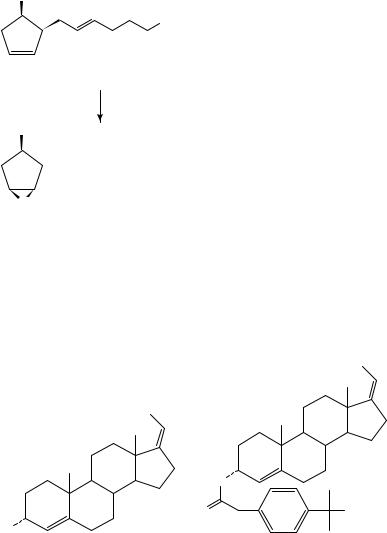
20. Oxidation of dienes and polyenes |
909 |
OH
CO2 CH3
(75)
(13)
OH
 CO2 CH3
CO2 CH3
O
(76)
A very interesting way to control alkene epoxidation was introduced by Breslow and Meresca114. In the steroid diene, 77, epoxidation takes place exclusively at the 4,5 double bond using Mo(CO)6 and TBHP. However, by attaching a template, as in 78, to the alcohol, the regioselectivity could be inverted so that epoxidation takes place only at the 17,20 double bond. It was concluded that the appendage did not act as a steric shield, but the remote tertiary alcohol moiety was transformed in situ to a hydroperoxide resulting in the observed selectivity by intramolecular epoxidation. This approach was then extended to other functionalized polyenes, such as farnesol and geranylgeraniol115.
|
O |
O |
OH |
HO |
|
(77) |
(78) |
The use of alkylhydroperoxides as epoxidizing agents for allylic alcohols under catalytic conditions was soon expanded into enantioselective epoxidation with use of the more mild titanium alkoxides in the presence of chiral tartaric esters116. As concerns the epoxidation of functionalized dienes, these now so-called Sharpless conditions [Ti(OPri)4, dialkyl tartrate, TBHP] have been utilized to enantioselectively epoxidize 1,4-pentadiene-
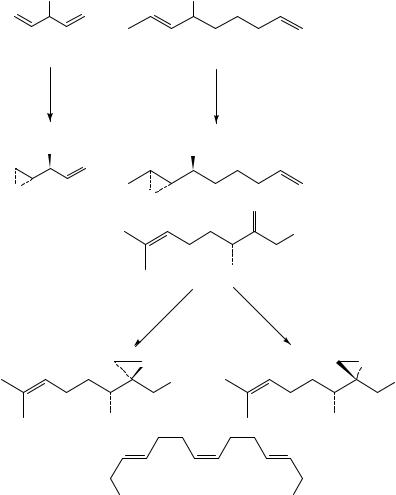
910 |
Ronny Neumann and Alexander M. Khenkin |
3-ol117 (79), 2,8-nonadiene-4-ol118 (80) (equation 14), geraniol and linalool at the allylic position119 as well as many others which have been complied in a recent review120. Steric factors may also play a role in the enantioselective formation of epoxy alcohols. Therefore, in the case of the optically active alcohol 81, use of (C) diisopropyl tartrate, (C)-DIPT, yields the desired epoxy alcohol in a 92% ee (‘matched pair’) whereas with ( ) diisopropyl tartrate, ( )-DIPT, only a 50% ee was observed in a ‘mismatched pair’ (equation 15)121. The triene 82 was also epoxidized with very high enantioselectivity122. Other important epoxy alcohols formed include squalene oxide analogs123, intermediate in the synthesis of marmine124 and virantmycin125. Recent examples of inverse enantioselectivity126 and the use of different chiral auxiliaries have been reported127.
|
OH |
OH |
|
|
(79) |
(80) |
|
Ti(OPr-i)4 |
|
Ti(OPr-i) |
|
TBHP |
|
4 |
(14) |
|
TBHP |
||
(+)-DIPT |
|
(+)-DIPT |
|
|
OH |
OH |
|
O |
O |
|
|
|
|
|
|
|
|
|
OH |
|
|
(81) |
|
|
|
Ti(OPr-i)4 |
(15) |
|
|
TBHP |
|
|
|
(+)-DIPT or (−)-DIPT |
|
|
O |
|
O |
|
|
OH |
OH |
OH |
HO |
(82)
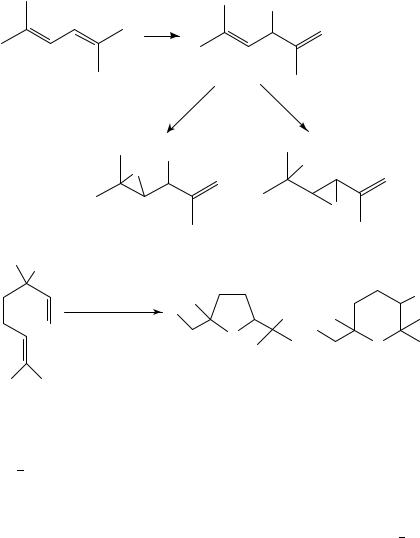
20. Oxidation of dienes and polyenes |
911 |
A further interesting extension of the allyl alcohol epoxidation reaction is the metalcatalyzed direct hydroxy-epoxidation of alkenes. In such a reaction an ene reaction with singlet oxygen, 1O2, or Schenk reaction forming an allylic hydroperoxide is combined with metal-catalyzed intramolecular epoxidation to form epoxy alcohols128. For example, with 2,5-dimethyl-2,4-hexadiene (83) two different isomers, 84 and 85, were obtained with Ti(OPr-i)4 and VO(acac)2, respectively (equation 16)129. Similar reactions were also carried out on dicyclopentadiene130 and ˛-ionone (60)131. Recently, a large pore bifunctional titanium-aluminosilicate was used to epoxidize and then cyclize linalool (86) to a mixture of furan and pyran derivatives in one step (equation 17)132. Other titanium-substituted silicates have also been used for the epoxidation of limonene133.
OOH
(83) |
Ti(OPr-i)4 |
VO(acac)2 |
|
||
|
|
(16) |
|
OH |
OH |
|
O |
|
|
|
|
|
|
O |
|
(84) |
(85) |
OH
TiO2 −Al2O3 −SiO2
TBHP
OH
OH +
O
O
(86)
(17)
Towards the end of this section it may be worthwhile to point out some new reactions with high-valent metals and TBHP. The first is a pyridinium dichromate PDC TBHP system134. Nonsubstituted or alkyl-substituted conjugated dienes, such as 1,3-cyclooctadiene (87) and others (also linear dienes), yield keto allyl peroxides 88 (equation 18), whereas phenyl-substituted dienes such as 1,4-diphenylbutadiene (89) gave diketo compounds, 90 (equation 19). In further research into a GIF-type system135 with iron and TBHP, limonene gave a mixture of products with carvone as the major product. The mechanism is thought to proceed initially by formation of a Fe(V) carbon
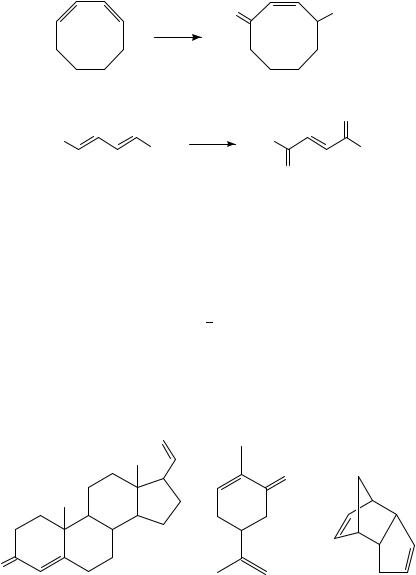
912 |
Ronny Neumann and Alexander M. Khenkin |
intermediate, followed in the presence of air to a peroxo intermediate, from which products are formed136.
O |
OOBu-t |
PDC |
|
TBHP |
(18) |
|
|
(87) |
(88) |
O
Ph |
Ph |
PDC |
|
TBHP |
|
|
|
(89)
2. Hydrogen peroxide
Ph
Ph
(19)
O
(90)
The use of hydrogen peroxide in catalytic oxidation of dienes is highly desirable from an economic and ecological point of view. However, there are relatively as yet few results in this still rather virgin field, especially compared to the significant success that has been obtained with TBHP and other alkyl hydroperoxides. Some of the earlier results showed that 1,5,9-cyclododecatriene, 1,4-cyclooctadiene and 1,3-cyclooctadiene could all be epoxidized in the range of 80 90% epoxide vs diol selectivity with simple oxides such as WO3, MoO3 and V2O5137. More recently, peroxotungstates of the type fPO4[W(O) O2 2]4g3 have been used to oxidize 4-vinylcyclohexene exclusively at the endocyclic double bond and the steroid 4,20-pregnadiene-3-one (91) at the 20,21
double bond138. Another pertungstate salt which has been used advantageously is the W2O112 Ð 2Ph3PCH2PhC compound139 which has been shown to catalyze the oxidation of limonene, geraniol, nerol and carvone (92). For limonene the endocyclic position is
O
O
(91) |
(92) |
(93) |

20. Oxidation of dienes and polyenes |
913 |
highly preferred, for nerol and geraniol the allylic position is most reactive whereas, in carvone, the ˛-keto group causes strong deactivation of the neighboring double bond leading to epoxidation at the 9,10 position. Use of the phosphotungstate, PW12O403 , leads to a mixture of monoand di-epoxides in the epoxidation of the tricyclic 93140. Similarly, PMo12O403 has been used in the oxidation of dienes with one allylic alcohol unit. The ˛-epoxy alcohols are the preferred products141. Recently, our group has also used a manganese-substituted polyoxometalate as catalyst for diene epoxidation with hydrogen peroxide142.
IV. OXIDATION WITH OXYGEN
The oxidation of organic compounds with molecular oxygen is a highly desirable goal stemming from its availability. From a thermodynamic point of view combustion products are of course always to be preferred, therefore specific methods and catalysts must be found to bring about selective reactions. Molecular oxygen is a triplet in its ground state making the direct reaction with the majority of organic substrates which are singlets, among them of course dienes and polyenes, a disallowed process. Only upon the input of a large amount of thermal energy, as in gas-phase reactions, can one bring about oxidation of organic substrates, but this has never been successfully done with dienes or polyenes. The use of molecular oxygen, therefore, in essence requires indirect methods for its activation and use in synthetic organic chemistry. In this section, we will discuss these methods. The first possibility is to excite the ground state molecular oxygen to an excited state forming singlet oxygen, 1O2. This is commonly done with light radiation using photosensitizers143. The singlet oxygen thus formed is highly reactive with organic substrates and has been especially and successfully used in the formation of numerous endoperoxides from conjugated dienes143. A second method commonly employed to use molecular oxygen in organic chemistry is to form hydrocarbon radicals144. These radicals react at a diffusion-controlled rate with molecular oxygen, forming peroxides. These intermediates can propagate a radical chain reaction, termed autooxidation, by formation of more hydrocarbon radicals and intermediate hydroperoxides. Initial formation of hydrocarbon radicals occurs occasionally due to thermal carbon hydrogen bond disassociation, although for most practical applications thermally sensitive initiators are employed. Alternatively, photoactivation as well as use of catalysts of sufficient oxidation potential may be considered in order to initialize radical formation. A third method to utilize molecular oxygen is to form metal dioxygen bonds which, under appropriate conditions, form highly active metal-oxo intermediates145. In nature, monooxygenase enzymes such as cytochrome P-450 or methane monooxygenase utilize reducing agents in order to split the oxygen oxygen bond. Dioxygenases are also known. Although many enzymatic systems have been discovered, they are as yet relatively poorly understood and have not been translated by comparable synthetic or biomimetic systems to diene oxidation. A fourth way to use molecular oxygen is as the secondary oxidant in a catalytic cycle. In such a cycle a primary oxidant, often a metal catalyst, is used to carry out the original oxidative transformation of the organic substrate. The reduced primary oxidant or metal catalyst can then be reoxidized by molecular oxygen. The most important prototype of this reaction is the palladium-catalyzed oxidation of alkenes, commonly termed the Wacker process or reaction146. A fifth and final method for employing molecular oxygen is to pass it between two electrodes at high voltages thereby producing ozone, O3. The latter is a highly potent oxidizing agent147.
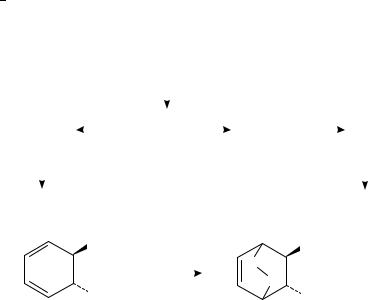
914 |
Ronny Neumann and Alexander M. Khenkin |
A. Singlet Oxygen
Singlet oxygen may be produced chemically by reaction of hydrogen peroxide and hypochlorite. The most useful procedure, however, is via sensitized photooxidation (equation 20). Light absorption of the sensitizer leads to formation of a sensitizer in the excited singlet state. In some cases, especially with electron-poor aromatics and ketones, a type I photooxidation will take place whereby electron transfer between the substrate and the excited state singlet sensitizers will yield a radical ion. The latter will react with ground triplet oxygen. These types of reactions will be discussed in the next section. More commonly, the excited singlet sensitizer, most commonly rose bengal, methylene blue and porphyrins, undergoes intersystem crossing to the triplet state and then reacts in a type II photooxidation with ground state oxygen to form singlet oxygen, which then reacts with the organic substrate to form product. The reaction of singlet oxygen with conjugated dienes forms endoperoxides as the initial product by a Diels Alder type reaction where singlet oxygen reacts as a dienophile148; the reaction of 94 to 95 (equation 21) is simply a fairly recent example149. Reactions are most efficiently selective to the endoperoxides at low temperatures in halogenated or deuterated solvents.
Sens
|
|
|
|
|
hν |
|
|
|
|
|
|
|
||
|
|
Type I |
|
|
|
ISC |
|
|
Type II |
|
|
|
||
Radical |
1Sens* |
|
3 Sens* |
|
|
1O2 |
||||||||
|
|
|
|
|
|
|
|
|||||||
|
|
|
|
|
|
|
||||||||
|
|
Substrate |
|
|
|
|
|
3 |
O2 |
|
|
(20) |
||
|
|
|
|
|
|
|
|
|
|
|
|
|
|
|
|
|
|
|
|
|
|
|
|
|
|
|
|
||
3O2 |
|
|
|
|
|
|
|
|
|
|
Substrate |
|
||
|
|
|
|
|
|
|
|
|
|
|
|
|
|
|
Oxygenated |
|
|
|
|
|
|
|
|
Oxygenated |
|||||
Product |
|
|
|
|
|
|
|
|
Product |
|||||
|
|
OCOCH3 |
|
|
|
|
|
|
OCOCH3 |
|
||||
|
|
|
|
|
1O2 |
O |
|
|
|
|
|
|
||
|
|
OCOCH3 |
|
|
|
|
O |
|
OCOCH3 |
(21) |
||||
|
|
|
|
|
|
|
||||||||
|
|
|
|
|
|
|
|
|||||||
|
|
|
|
|
|
|
|
|
||||||
(94) |
|
|
|
|
|
|
(95) |
|
|
|
|
|||
Kinetic measurements showed the following |
relative rates for oxidation with |
|||||||||||||
singlet oxygen with representative conjugated dienes: 1,3-cyclooctadiene |
< 2-cis- |
|||||||||||||
4-trans-hexadiene < 2-trans-4-trans-hexadiene ¾ 1,3-pentadiene < 1,3-cycloheptadiene < 1,3-cyclohexadiene < 1,3-cyclopentadiene150. The slow reactions of the eightmembered and larger rings are attributed to the lack of planarity of the diene151. The slower rate of addition for acyclic dienes vs cyclic dienes often causes formation of byproducts such as dioxetanes and hydroperoxides in the reaction of the former, which are rarely observed in the latter. An interesting example showing both formation of the hydroperoxide in acyclic dienes and endoperoxide formation in cyclic hexadienes was observed in the oxidation of neoabietic acid (96) to the endoperoxide 97 (equation 22)152.
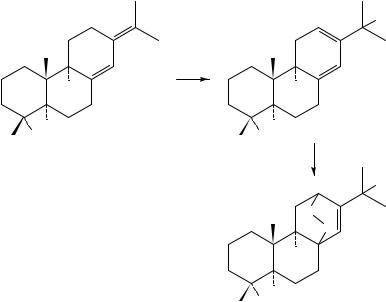
20. Oxidation of dienes and polyenes |
915 |
OOH
H |
H |
H |
H |
COOH |
COOH |
(96) |
(22) |
|
OOH |
|
O |
|
O |
|
H |
|
H |
|
COOH |
|
(97) |
The literature on the oxidation of dienes with singlet oxygen is very voluminous and only recently both the mechanistic and synthetic aspects of this reaction have been very thoroughly reviewed and therefore will not be repeated here153. It is worth pointing out that the stable endoperoxides formed in the addition of singlet oxygen to conjugated dienes may be manipulated in many ways to form further interesting products, for example by reduction154 or rearrangement155. Products which may be obtained include acids, ketones and aldehydes, alcohols, epoxides and others depending on the specific additional conditions applied during or after the singlet oxygen reaction.
Non-conjugated dienes react differently with singlet oxygen. In such substrates each alkene reacts as a separate entity with allylic hydroperoxides being the predominant product via the Schenk reaction156. Regioselectivities in such reactions vary to a great degree. The general rule of thumb is that the hydroperoxide is most easily formed at the allylic hydrogen orthogonal to the alkene plane157 due to the electronic requirement for overlap between p orbitals of the developing double bond in the transition state158. It has been shown that functional groups may affect regioselectivity, for instance in the oxidation of ˛, ˇ-unsaturated ketones159. Stereoselectivity in reactions of non-conjugated dienes with singlet oxygen is a newly found phenomenon. In connection with the synthesis of calcitriol (dihydroxyvitamin D3) both remarkably high regioand stereoselectivities were observed160. A further investigation has shown that the selectivities obtained are due to a combination of electronic and steric effects where addition of carboxylic acid substituents lead to selectivity161.
Finally, another interesting use of singlet oxygen in the oxidation of dienes concerns the reactivity of allenes. Besides the formation of endoperoxides by addition to dienes and hydroperoxide formation via the ene reaction, singlet oxygen reacts with electron-rich
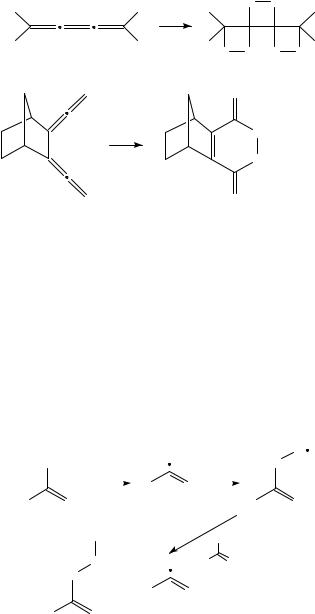
916 |
Ronny Neumann and Alexander M. Khenkin |
alkenes to form dioxetanes. Allenes react in this manner162. Thus, the triene 98 yields 99 (equation 23)163. Similarly, an adamantane disubstituted allene also yields the same type of product164. Dioxetane formation was also observed in the reaction of the norbornene derivative 100 to yield 101 (equation 24)165.
|
O |
O |
|
|
|
|
(23) |
|
O O |
O O |
|
|
(98) |
(99) |
|
|
O |
|
|
|
O |
(24) |
|
|
|
||
(100) |
(101) |
|
|
B. Triplet Ground State Oxygen
As stated above, reaction of triplet ground state molecular oxygen with a singlet organic substrate requires formation of a radical (atom transfer) or cation radical (electron transfer) from the former to an initiator or catalyst. This type of chemistry has been realized in a variety of ways. One common scheme is to mix an aldehyde, alkene and dioxygen often in the presence of a catalyst166. Since aldehydes are relatively sensitive to hydrogen abstraction, peracids are easily formed in this manner (equation 25). The peracids may then quickly react with the alkenes, also dienes and polyenes, in the reaction mixture to form epoxides. Although these are technically reactions with molecular oxygen, the reactivity and mechanism is more similar to that of organic peracids. A recent example of the use of this technique is in the oxidation of 3-hydroxy-7-methyl-1,6-octadiene to the expected epoxide at the nonallylic position167. There has been no further systematic study of diene oxidation using these systems.
|
|
|
|
|
|
|
O |
|
H |
|
|
|
O |
||
|
|
Initiator |
|
O2 |
|
||
|
|
|
R |
O |
|
R |
O |
|
|
|
|
||||
R |
O |
|
|
||||
|
H |
(25) |
|
H |
|
|
O |
R O |
|
O |
|
|
+ R |
O |
R |
O |
|
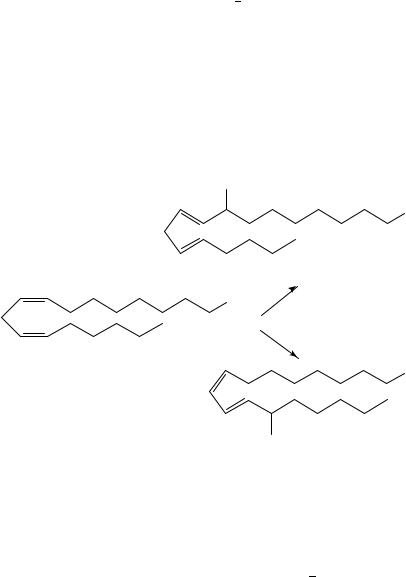
20. Oxidation of dienes and polyenes |
917 |
Reaction of molecular oxygen with radicals formed directly from dienes is a subject of chemical, medicinal and biological interest168. The polyenes of most interest are the fatty acids, linoleic acid (cis,cis-9,12-octadecadienoic acid), -linolenic acid (cis,cis,cis- 6,9,12-octadecatrienoic acid), ˛-linolenic acid (cis,cis,cis-9,12,15-octadecatrienoic acid), arachidonic acid (cis,cis,cis,cis-5,8,11,14-eicosatetraenoic acid) and polyenes from the prostaglandin family of compounds. The polyunsaturated acids are important components of membranes and the prostaglandins are important regulatory compounds. The autooxidation of these compounds has often been associated with aging and disease. Using linoleic acid as a model it has been found that carbon hydrogen bond strengths are 82, 87 and 95 kcal mol 1 for the bisallylic, allylic and nonallylic secondary carbons, respectively169. Therefore, autooxidation using free radical initiators will predominantly, but not only, yield hydroperoxides at the bisallylic positions. A report on a unified mechanism of polyunsaturated acid autooxidation including kinetic measurements has been carried out for linoleic170 and triene and tetraene acids171. Enzymatic oxidation using lipoxygenase enzymes, however, yields specific products. Thus, for example, using maize lipoxygenase, hydrogen abstraction at the bisallylic position of linoleic acid (102) is accompanied by isomerization of the double bond and stereospecific formation of 9-d-hydroperoxy- trans,cis-10,12-octadecadienoic acid (103). Soybean lipoxygenase will similarly yield the hydroperoxide at the C-13 carbon, i.e. 13-l-hydroperoxy-cis,trans-9,11-octadecadienoic acid (104) (equation 26)172.
OOH
COOH
(103)
COOH
(26)
(102)
COOH
OOH
(104)
In the case of arachidonic acid, lipoxygenase enzymes will yield hydroperoxyeicosatetraenoic acids (HPETEs), which may then be enzymatically manipulated to leukotrienes by controlled dehydration or to endoperoxide prostaglandins such as PGG2 by cyclooxidation173. The non-enzymatic reaction of diene hydroperoxides, for example 105 to form the hydroperoxide-endoperoxide 106, has been studied (equation 27). Many additional substrates have been studied including 1-hydroperoxy-3,5-hexadiene and 1- hydroperoxy-4,8-undecadiene174. Similarly, the reaction of the fatty acid hydroperoxides under acid conditions (Hock rearrangement) gives both carbon carbon bond cleavage and
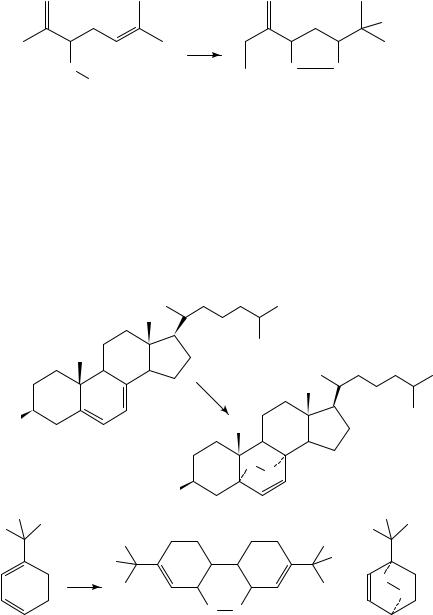
918 |
Ronny Neumann and Alexander M. Khenkin |
ether formation175, e.g. colneleic acid176 via intermediate epoxides. These product types are associated with formation of organic volatiles in food degradation.
OOH
(27)
O |
O |
O |
OH |
|
|
(105) |
|
(106) |
Another interest in the use of triplet oxygen lies in the oxidation of dienes with photochemical activation (Type I, above) with formation of endoperoxides as products. The first example of this reaction was observed in the early 1970’s. Thus, reaction of ergosteryl acetate (107) in the presence of trityl tetrafluoroborate177 and Lewis acids178 in the presence of light yielded the endoperoxide 108 (equation 28). With certain Lewis acids this reaction could be thermally, rather than photochemically, activated. Cation radicals were shown to be the intermediate active species, as was borne out by a comparative oxidation of the isomeric lumisteryl acetate which was inactive under these conditions but reacted easily with singlet oxygen179. This reaction was later extended to other substrates. Thus, the intermediacy of cation radicals was also indirectly observed by the fact that the t-butyl substituted 1,3-cyclodiene 109 gave a ‘dimeric’ product 110 (equation 29) via the cation radical intermediate in addition to the usual endoperoxide 110a180.
(28)
AcO
(107)
O
O
AcO
(108)
|
|
+ |
O |
(29) |
|
|
O |
|
|
|
|
|
|
|
|
O O |
|
|
|
(109) |
(110) |
|
(110a) |
|
